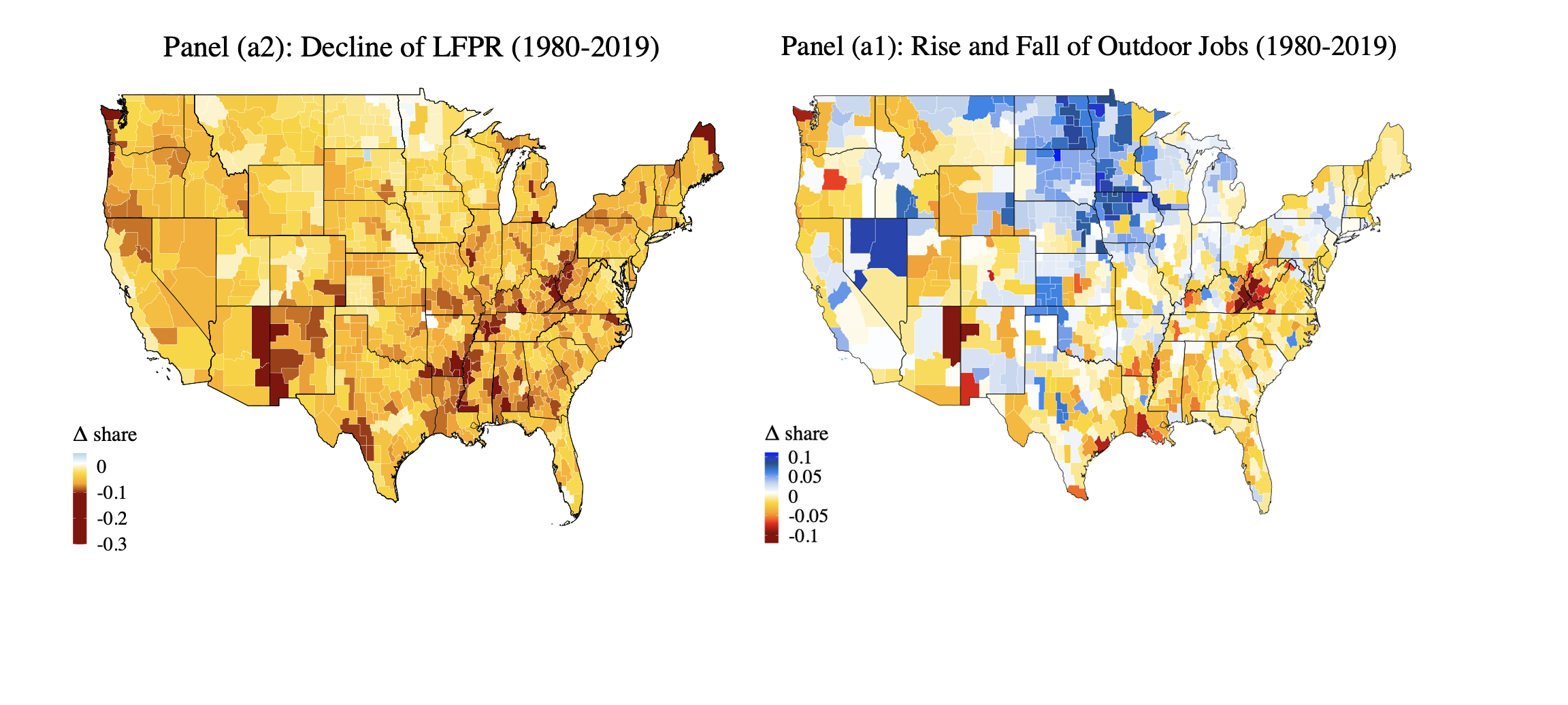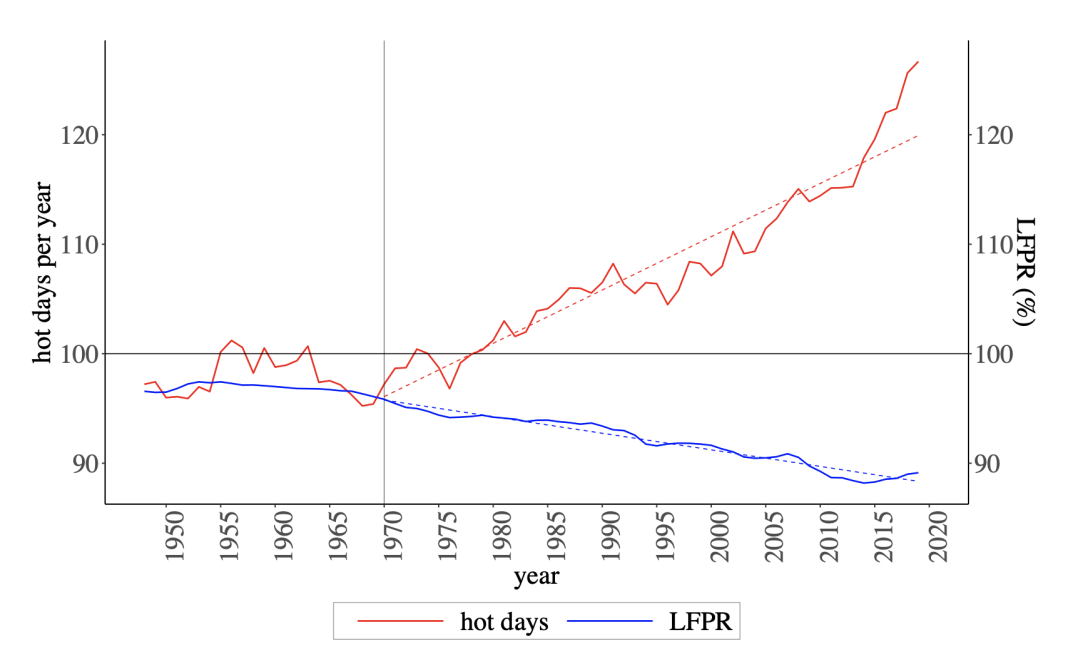Masahiro Yoshida from Waseda University’s Department of Political Science and Economics explores the link between global warming and male labor force participation
The Earth has become the hottest planet on record. Global temperature increase has been unprecedented for two millennia, (1) since the late 19th century. Temperatures have steadily risen since the 1970s and accelerated further after 2000. In July 2023, United Nations Secretary-General António Guterres announced, “The era of global warming has ended. The era of global boiling has arrived.” This project proposes a new hypothesis suggesting that climate change, particularly the rising temperatures since 2000, has contributed to a significant decline in the labor force participation rate (LFPR) of adult males – a trend that is widely observed in developed countries, but is most pronounced in the United States.
Figure 1 shows that over a half-century (1970-2019), the number of hot days nationwide has increased by 29.5 days per year in the US. Simultaneously, the US’s LFPR for prime-age males (ages 25-54) has steadily declined since about 1970, reaching less than 90% in 2019, reflecting the nation’s socioeconomic divide.
The rise of outdoor jobs in the labor market polarization I highlight the underappreciated role of ‘outdoor jobs’ to bridge a seemingly unrelated coincidence. I document that, consistently since 1970, one-third of all working-age men have engaged in regular outdoor work, typically in construction, transportation, and service (e.g., lawn mowing), as identified by the O*NET Work Context Survey. Intriguingly, over 75% of the outdoor workers are men, and over 80% do not have a college degree. I find that non-college graduates are increasingly employed in outdoor jobs, presumably ‘locked out’ of indoor jobs, while middle-income indoor jobs (e.g., manufacturing) have evaporated over time under technological revolution and globalization.
Outdoor jobs vs. home as a cooling lounge
Imagine an adult male working outdoors under more frequent exposure to hot days. He would experience physical fatigue, sweating, and mental discomfort, putting him at higher risk for heat stroke, operational errors, and subsequent injury. Intriguingly, since the 1960s, residential air conditioning and cable TV subscriptions were introduced into the home, and the relative cost of working outdoors vs. staying at home should have increased. Therefore, climate change would push the outdoor worker out of the labor force and into the home, even though he is unlikely to be aware of climate change.

A ‘natural’ experiment in the US continent
To test the hypothesis mentioned above, I created a panel dataset that examines the relationship between regional exposure to climate change and the labor force participation rates (LFPR) of prime-age males across 722 commuting zones in the United States from 1980 to 2019. Regional climate change is assessed using nearly fifty years of daily records on temperature, humidity, precipitation, and snowfall collected from 15,000 weather stations across the country.
Using this dataset in a statistical ‘natural’ experiment, I found that ten more hot days (above 75°F) and ten more cold days (below 35°F) per year in the five-year average significantly harm prime-age male LFPR by 0.3-0.4 percentage points, and consequently, increase the share of dropouts, who are either not employed, unemployed, or not in school.
The response is systematically stronger for less educated males and males under 45. The harm is pronounced in areas dependent on outdoor jobs, especially in disadvantaged rural areas, where fewer alternative indoor jobs (e.g., restaurant waiter, supermarket cashier, office clerk) are available as ‘climate shelters’. Intriguingly, the regional decline in the LFPR is closely associated with the loss of outdoor jobs, as illustrated in Figure 2. The loss of outdoor jobs is widespread across industries, but is most striking in construction.
Mechanism: Disability vs. lifestyle change?
I found that extreme temperature days are associated with self-reported disabilities and an increase in Social Security Disability Insurance (SSDI) recipients with physical and mental disorders. However, research indicates that climate change has also led to an even larger number of non-disabled individuals dropping out of the workforce, suggesting that disability is not the only factor at play. Furthermore, the impact of climate change appears to be exacerbated by the availability of housing amenities, such as air conditioning and color TVs. This suggests that climate-induced dropouts are not solely the result of public health crises but can also be seen as a lifestyle adaptation. Since pre-industrial times, adult males have traditionally had an advantage in outdoor work, but modern climate change has disrupted this established role of masculinity.
Impact: 15% of declining adult male labor supply in the 21st century
The impact of climate change on labor force participation is significant. From 2000 to 2019, climate change reduced 0.44 percentage points in the labor force participation rate (LFPR) of prime-aged males, accounting for 15% of the overall national decline. 72% of individuals out of the workforce or not in school due to climate change had less education, either graduating from or dropping out of high school. Notably, the 20 largest urban cities, which comprise 40% of the population, accounted for only 4.0% of the climate-induced dropouts. This suggests that most of the dropouts occurred in disadvantaged rural areas. If climate change continues to accelerate, it will likely worsen socioeconomic inequality.
Policy: Prevent heat stress and dropout
Encouragingly, some states have already implemented measures to protect against extreme heat (see California). A typical policy package includes basic solutions to prevent further dropouts, such as flexible schedules, personal protective equipment like cooling vests, and easy access to water, shade, and air conditioning. However, these mandated regulations may unintentionally lead to reduced employment, as companies might redistribute labor, exit the market, or automate manual tasks. The overall impact of these regulations will need to be assessed in future studies.
References
- Esper, Torbenson and Büntgen (2024). ‘2023 Summer Warmth Unparalleled over the Past 2,000 Years.’ Nature, 631, 94–97.


